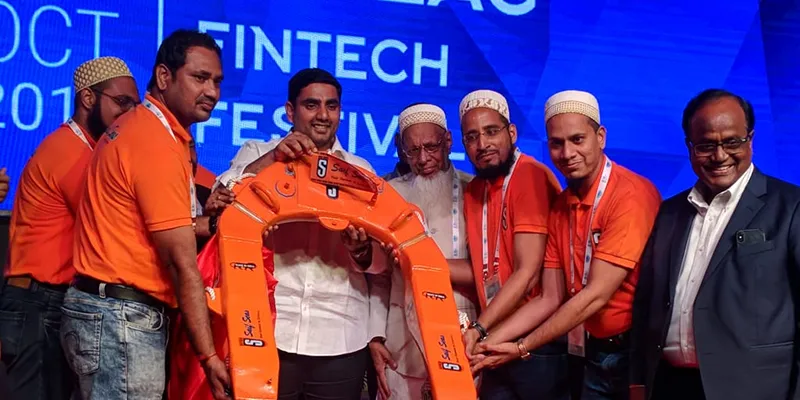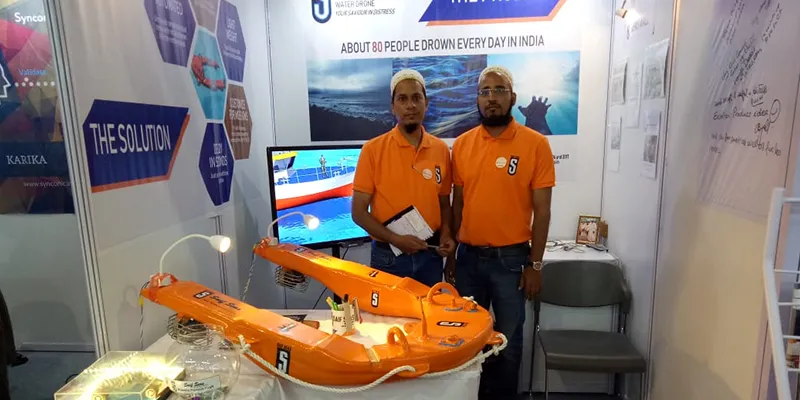Vizag-based Saif Automation’s water drone will help prevent people from drowning
Saif Automation has developed an unmanned remote-controlled water drone that has uses in both defence and civilian sectors.
You can call it a lifeguard startup. Vizag-based Saif Automation, currently incubated in Andhra Pradesh Innovation Society, has developed a prototype of a drone that can be deployed in an emergency situation arising at sea or in water bodies. The company aims to help in reducing incidents of drowning at least in places where the drone is deployed.
The beginning of Saif Automation
In 2017, 40-year-old Aliasgar Calcuttawala, after completing his post-graduation in Mechatronics at University of Siegen of Germany, started working with his father and brother in their trading business that caters to the marine industry in Kolkata.

“We opened a branch in Visakhapatnam in 2008 under the name of EAC Marine Pvt Ltd. We started working with defence agencies like the Indian Coast Guard and the Indian Navy. We also started ship repair and fabrication of different civilian vessels," says Aliasgar.
As the coastline of Visakhapatnam is very rough, he would come across drowning reports in newspapers every day. “We had the requisite experience in the marine industry, and came up with the idea of rescuing people in distress,” he says.
Aliasgar, along with his father Ahmed S Abdeally, and his brother Taher Ahmed co-founded Saif Automation, and came up with the idea of the 'Sea Water Drone'. Aliasgar says, “My father started working in Engineering Appliances Corporation in 1961 in Calcutta to cater to marine and steel plants industry. The company supplies tools, hardware, hydraulics items and pneumatic items to clients. Our core strength was in the marine industry, with clients like the Shipping Corporation of India, Great Eastern Shipping, Mercator Lines, Essar Shipping and ONGC. We have been visiting these ships since our childhood days to understand the issues better.”
While Taher has been working with his father since day one, Aliasgar initially worked for Bharat Electronics Limited in 2001-2004 in its telecom and broadcast, strategic business unit (SBU). He went to Germany for his post-graduation and returned to India in 2007. Taher has been taking care of marketing for the startup and Aliasgar is a robotics expert.
The startup was incorporated early this year. Aliasgar says it was his father, who is now 90, motivated him to start something of this own. He says, “We have already applied for patents. The National Research Development Corporation is sponsoring our patent application.” NRDC is an enterprise of the Department of Scientific and Industrial Research, Ministry of Science and Technology.
Also Read: Beyond IT and fintech, Andhra Pradesh is looking to become India’s happiest state, says Nara Lokesh
Challenges and process
“In September 2017, we decided to design the water drone. There were plenty of engineering challenges like power calculation, shape and volume calculations, weight and buoyancy parameters, aerodynamic, pressure testing and other complex engineering calculations. We recruited interns from IITs. That partly solved the problem. Then there were issues like crafts should be easily serviceable. We have a lot of friends in the ship repairing industry and they helped us to resolve many issues," says Aliasgar.
The prototype was completed in May this year. The drone has a dedicated radio communication from its remote to the craft. “The drone is not dependent on the internet or any tower signal. This is particularly helpful because, in the event of a cyclone or earthquake, there will be network issues. We worked on free radio frequency. The drone once thrown on a water surface can go at a speed of 7 knots (i.e. 14 metres per second). No human can match this speed," he adds.

If a crew member sees a person drowning, they can immediately throw the drone out into the sea. With the handheld remote, they can control and manoeuvre the drone until it reaches and picks the drowning person and comes back to the ship/boat.
The startup has designed more than 12 models of the drone for different purposes - tourism and entertainment, saving lives, surveillance, delivering medicines in flood-affected areas, etc.
The company is bootstrapped and currently has a team of six for designing the drone. While the design, electronics and testing are being done by the startup, it has outsourced the hull manufacturing to third parties.
Some features of the drone
- Unmanned remote controlled
- String 3km communication range for remotes, extendable up to 10 km
- Two hours to get fully charged
- Weighs around 12 kg
- A long-lasting battery with 45 minutes on moderate load and eight hours of GPS tracking.
- Can be fitted with HD camera, robotic probes or weaponry
Market and future plans
The startup is looking at beach authorities, water body authorities, municipalities and dam authorities as potential clients. “India has more than 176 lakes, over 34 ghats, 3,200 dams and barges, and more than 17 major rivers and tributaries, and more than 7,500 km of coastline. The opportunities are plenty,” adds Alisagar.
Saif Automation is still working on the cost of drones. He says, “We can also cater to defence agencies apart from looking at the export market.”
The firm is rolling out its first unit in the market by the end of this month. It is planning to sell around 500 units by the end of the year. By the end of the next financial year, it plans to sell more than 2,000 units.










